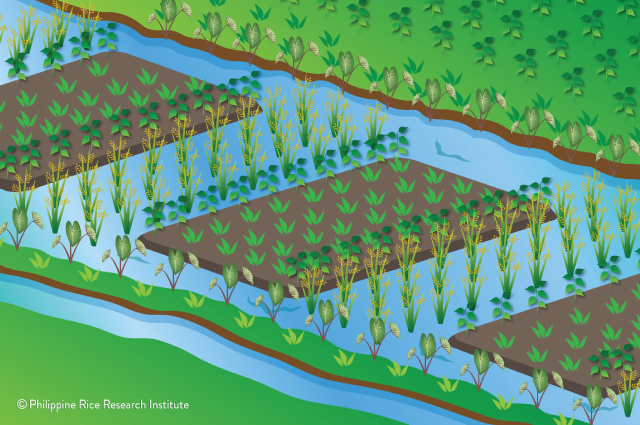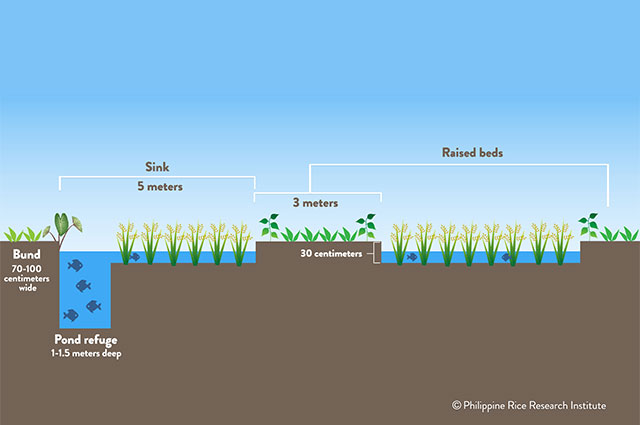The Philippines
August 11, 2016
As La Niña is forecasted to hit the country this year, there’s a heightened need to develop technologies that will enable the adaptability and economic stability of rice-based farming communities.
Experts from the Philippine Rice Research Institute (PhilRice) have evaluated the Sorjan cropping system in response to climate change, to maximize farm productivity, and ensure food security and regular income of farming families.
Sorjan, developed by Indonesian farmers, is a system that constructs an alternate of deep sinks and raised beds. Its features can adapt to both dry and wet seasons.

Climate change and farm productivity
“This is a good climate change adaptation technology in both flood- and drought-prone rice areas,” said Rizal G. Corales, lead of PhilRice’s Intensified Rice-Based AgriBioSystems (IRBAS) Program.
In the flood-prone or swampy areas, the sink impounds more water and can tame the flow of water. Meanwhile, the raised beds and bunds constructed in making the sink allow farmers to plant dryland crops such as vegetables and cash crops.
Corales explained that the sink of the Sorjan system can serve as rain water harvesting or impounding mechanism for farmers in drought-prone areas.
“The sink with the impounded water can be used for rice production and other crops like gabi or kangkong, and for fish production. The water stored in the sink can later be used for irrigation,” he added.
PhilRice experts noted that the ideal dimension of the raised bed is around 3m wide and 30cm above water level. The bund around the area, on the other hand, is about 70-100cm wide and 30cm high. The sink for rice and gabi production ranges from 3-5m wide and 30cm deep while a deeper sink of about 1m wide and 1-1.5m deep can be constructed around the area for fish production.
PhilRice highly encourages the integration of rice, vegetables, and fish. Depending on the season, Corales enumerated the vegetables that can be grown with Sorjan: eggplant, pepper, tomatoes, upland kangkong, bush beans, cowpea, pechay, mustard, kale, lettuce, spinach, okra, corn, and herbs.
The fish component may include cat fish, gourami, or tilapia. The bunds, on the other hand, can be planted with okra and bush or pole beans.
Sorjan also offers flexibility. Farmers may opt to plant vine vegetables like winged bean, bottle gourd, bitter gourd, ridge gourd, or squash on trellises as an overhead feature right on top of the sink.

Food and income security
Sorjan as a diversified and integrated farming system ensures food security as family have varied sources of food. There’s rice for carbohydrates, fish for protein, and vegetables with high nutritional value. The system ensures more stable income for the family because of the regular cash flow from the diversified and high-value crops.
“Literature cited that the Sorjan cropping system can generate an income up to 10 times higher than the income from rice with the same piece of land, which we are trying to prove,” Corales shared.
As rice production takes about 4-5 months, many rice farmers have little to no income while waiting for harvest.
Corales and his team recognize this situation of farmers having no other sources of income. This reality reinforces Sorjan’s potential to help farmers generate income from other crops while waiting for rice harvesting.
“With Sorjan, the production can support the family’s daily food requirements and expenses. Thus, putting the rice income later as savings or as capital for other income generating endeavors,” Corales concluded.
To maximize farm productivity and reduce production costs, non-marketable products such as vegetable discards or rejects, weeds, and other crop residues and biomass can be used as feeds of livestock, substrate for mushroom, or vermicomposting.
The system is continuously being developed at the Institute to identify the right combination of crops, and what crops can best adapt to this system. Nevertheless, the IRBAS team encourages local farmers to try Sorjan in their respective farms with an area as small as 1,000 square meters.
For more details, contact the IRBAS office at (044) 456-0258 local 340 or the PhilRice Text Center at 0920-911-1398.